
By Jessica Holmes
Thank you for joining me today, everybody. I hope we’ve all got our visitor’s passes and will be keeping our hands to ourselves, because today we’re going to be taking a tour of The Space Museum, and the main exhibit? The Doctor and his companions! Today’s serial was written by Glyn Jones.
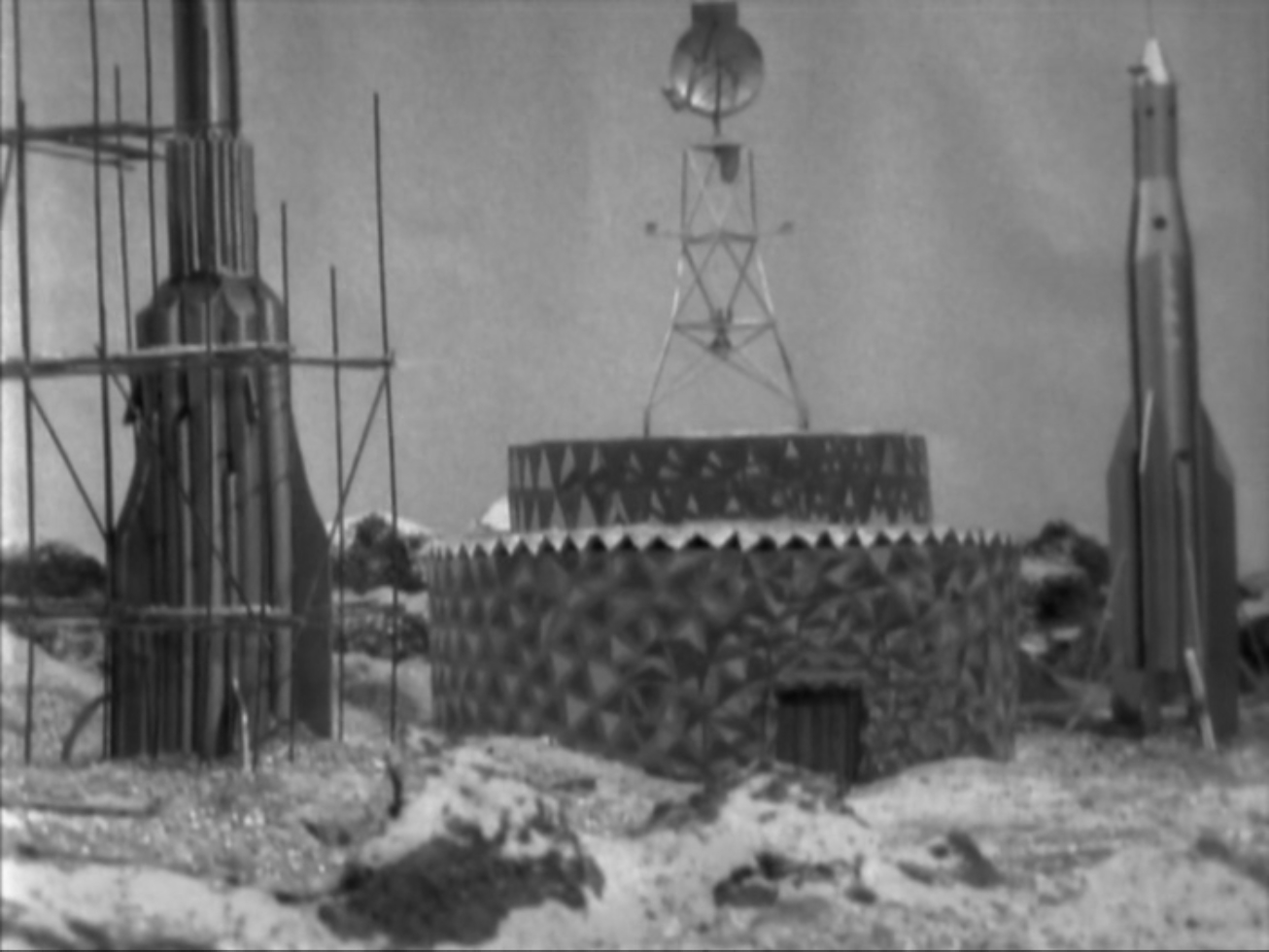
THE SPACE MUSEUM
If I may direct your attention to the opening of the episode, we can see that it picks up where it left off, with the TARDIS going dark. We then cut to a barren landscape dotted by rockets, among which the TARDIS materialises.
The crew seems dazed upon landing, and once the Doctor gets the lights back on, Ian and Barbara realise that somehow, they’ve changed their whole outfits.
 I used to wear socks like that for primary school…
I used to wear socks like that for primary school…
We have a scene of Vicki getting water for the Doctor, only to drop the glass, spilling the water, which then un-spills and comes back to her hand. It’s a simple enough effect, but rather nifty, and it seems things might be a whole lot weirder than a change of wardrobe.
Upon viewing the spaceships outside, the Doctor comes to suspect, as they’re all from different time periods, that they’ve landed in some sort of museum. I wonder if they have a little shop? I like a little shop.
The group search for signs of life, leaving no footprints behind them as they walk. The gang soon find a building and some more people. They rush to hide, but when Vicki sneezes, it’s as if they didn’t hear her at all.
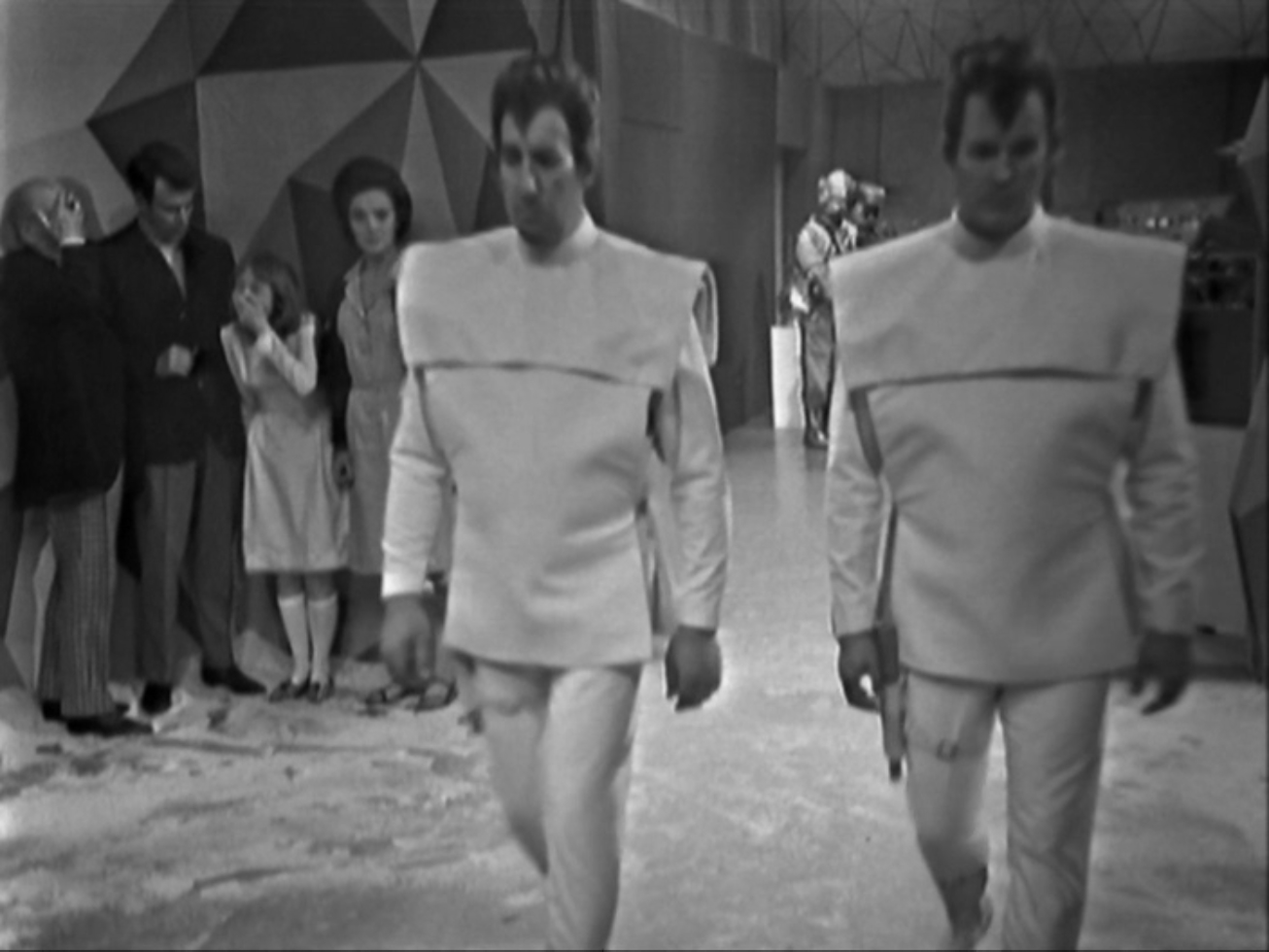
Perhaps unwisely, the group enters the building to look around without even buying a ticket.
The gang get a nasty shock upon discovering the first item of interest. It’s a Dalek. A dead Dalek. Vicki, never having met the fiends, thinks it looks quite friendly. I really do love Vicki’s soft spot for creatures others might deem monstrous. Well, they’d be absolutely right in the case of the Dalek, but still. It’s sweet.
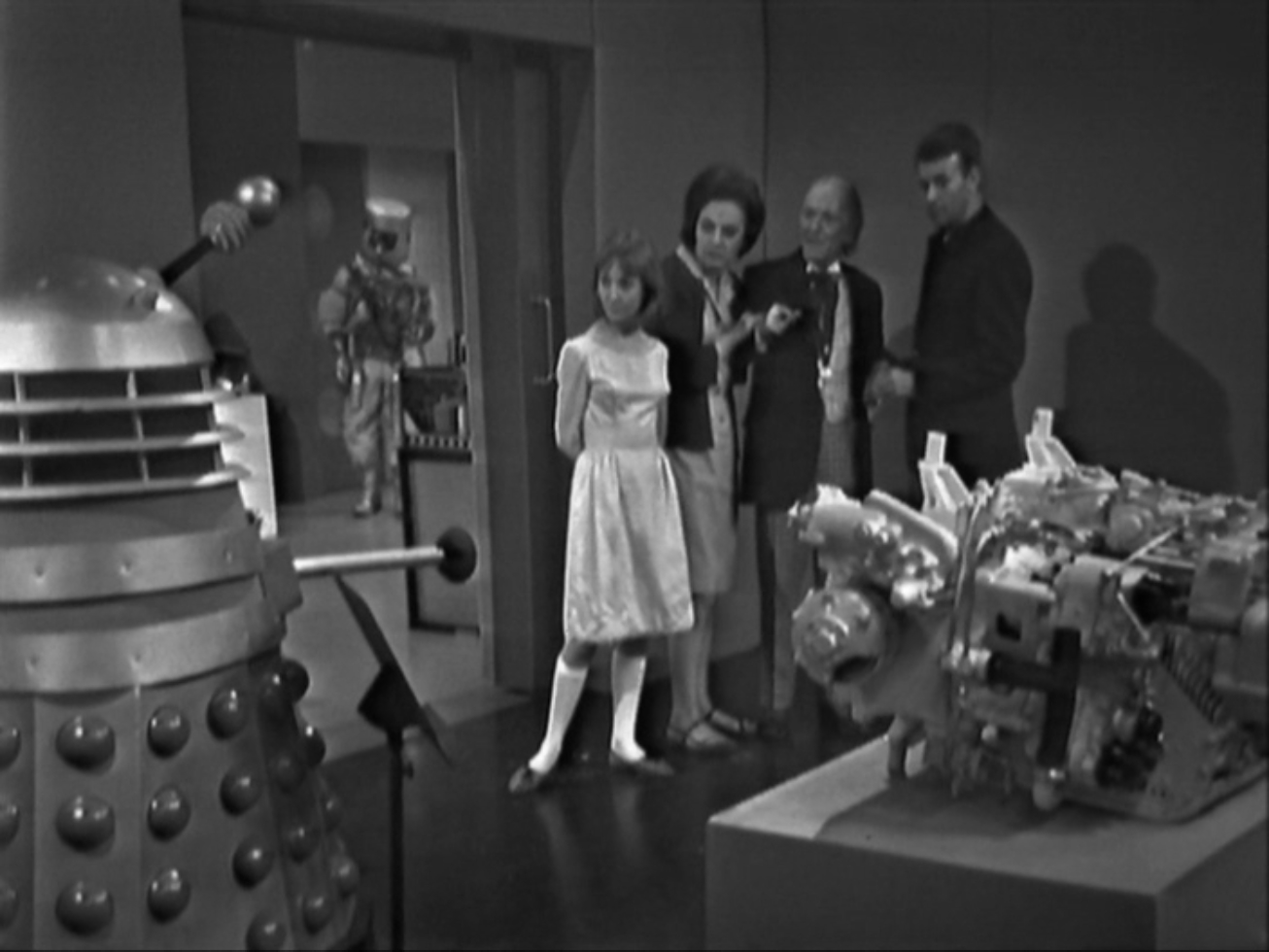
They have another run-in with some men, whose lips move but make no sound. That almost sounds like the opening to a riddle.
Think things can’t get any stranger? Think again! Caving to the urge to touch the shiny space exhibits, Vicki tries poking at an item only to find that her arm goes straight through. None of the others can touch it either, and a third group of men come by, looking right through them without seeing them.
Sorry, guys, but there’s only one conclusion: the TARDIS blew up and you’re all ghosts. I can think of worse places to haunt than a museum, so it’s not all bad.
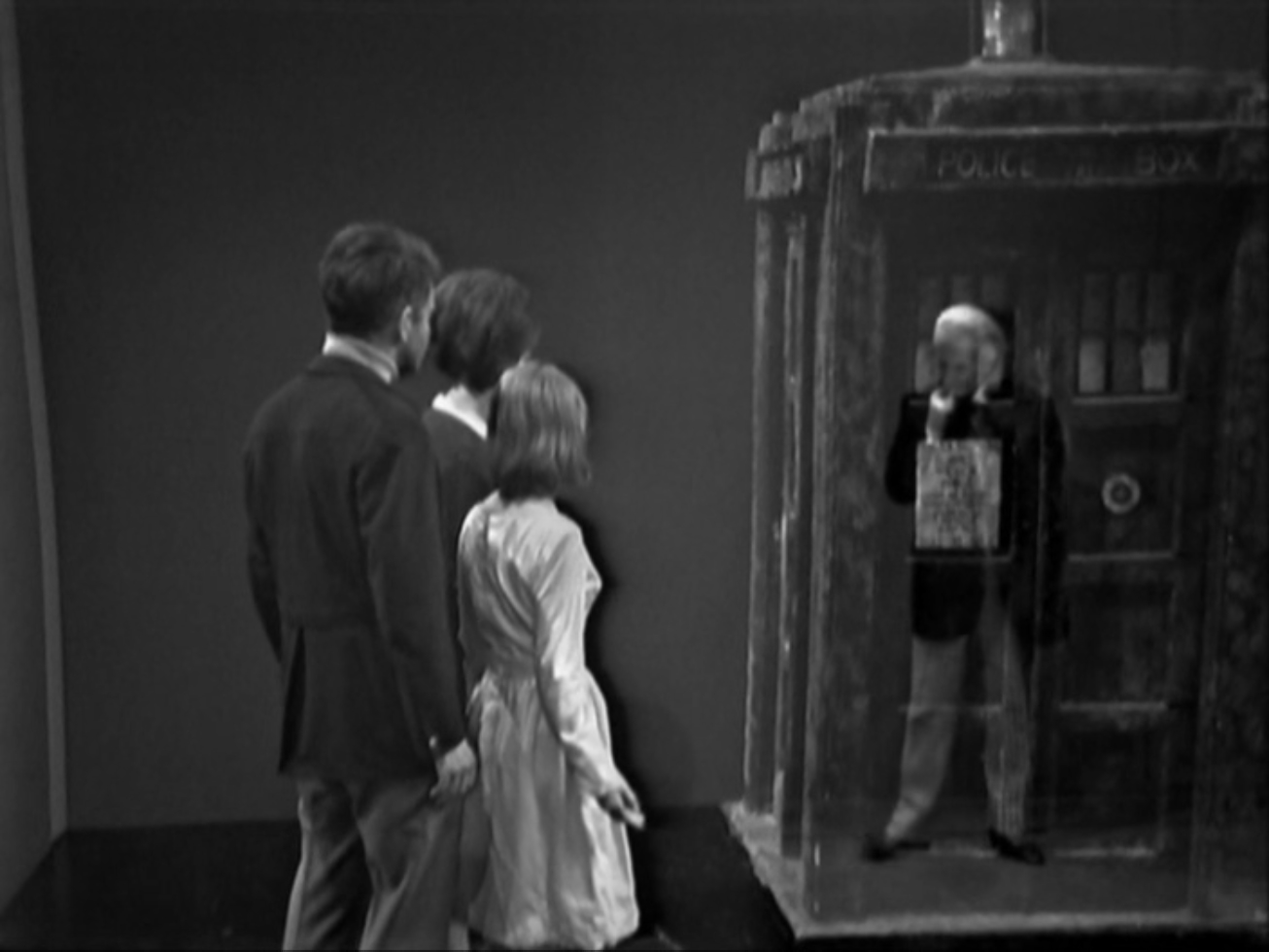 My gut instinct says Pepper's Ghost so just take my word for it, okay?
My gut instinct says Pepper's Ghost so just take my word for it, okay?
Onwards, they find something quite unexpected: the TARDIS, but not where they originally left it. Still, one shouldn’t look a gift horse in the mouth so they decide they might as well get in and go home for a nice cup of tea and some custard creams. Of course, it’s not that easy. The TARDIS isn’t really there. Or is it? Perhaps they’re the ones who aren’t really there.
Out of curiosity, I did a bit of research to find out how they achieved this visual effect. In conclusion: I’m not sure, and that irks me. My guess is either a double exposure or Pepper’s Ghost.
Or magic.
Something wicked this way comes, for in the room holding the TARDIS, the crew find themselves. Literally.
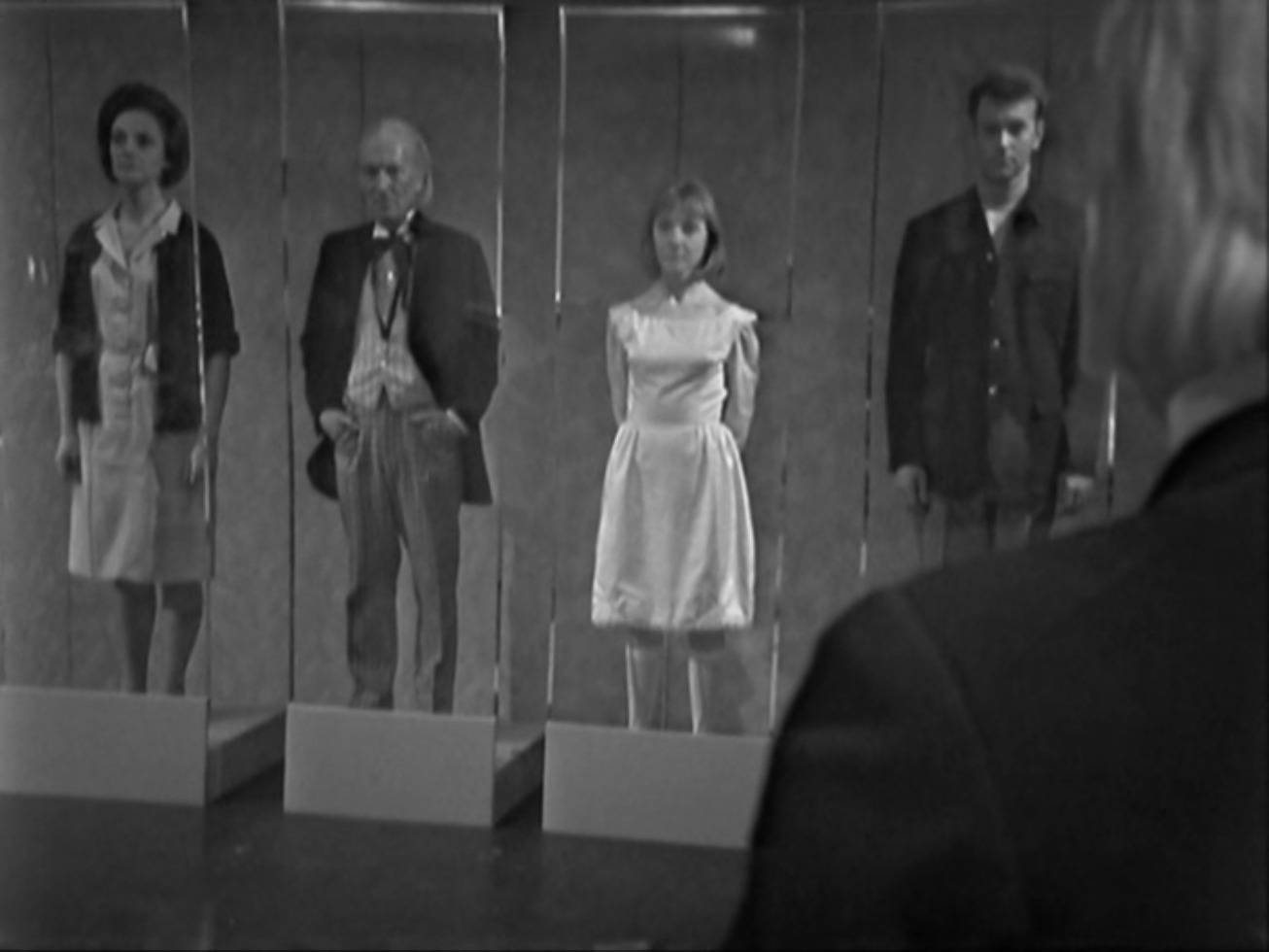
It seems the gang’s exploits have earned them a spot in the museum. These aren’t dummies though, oh no. These are the real people, preserved and shoved into a glass cabinet to gather dust for eternity.
The gang arrive at the conclusion that what they’re seeing is their future, or at least a possible version of it. There’s a bit of technobabble about dimensions in time and jumping time tracks that I can’t quite wrap my head around, but the bottom line is that the reason they can’t interact with anything in the museum is that they haven’t actually arrived yet, but are in another time dimension seeing the museum as it will be after they’ve arrived and done…something or other.
Don’t worry, it gives me a bit of a headache too.
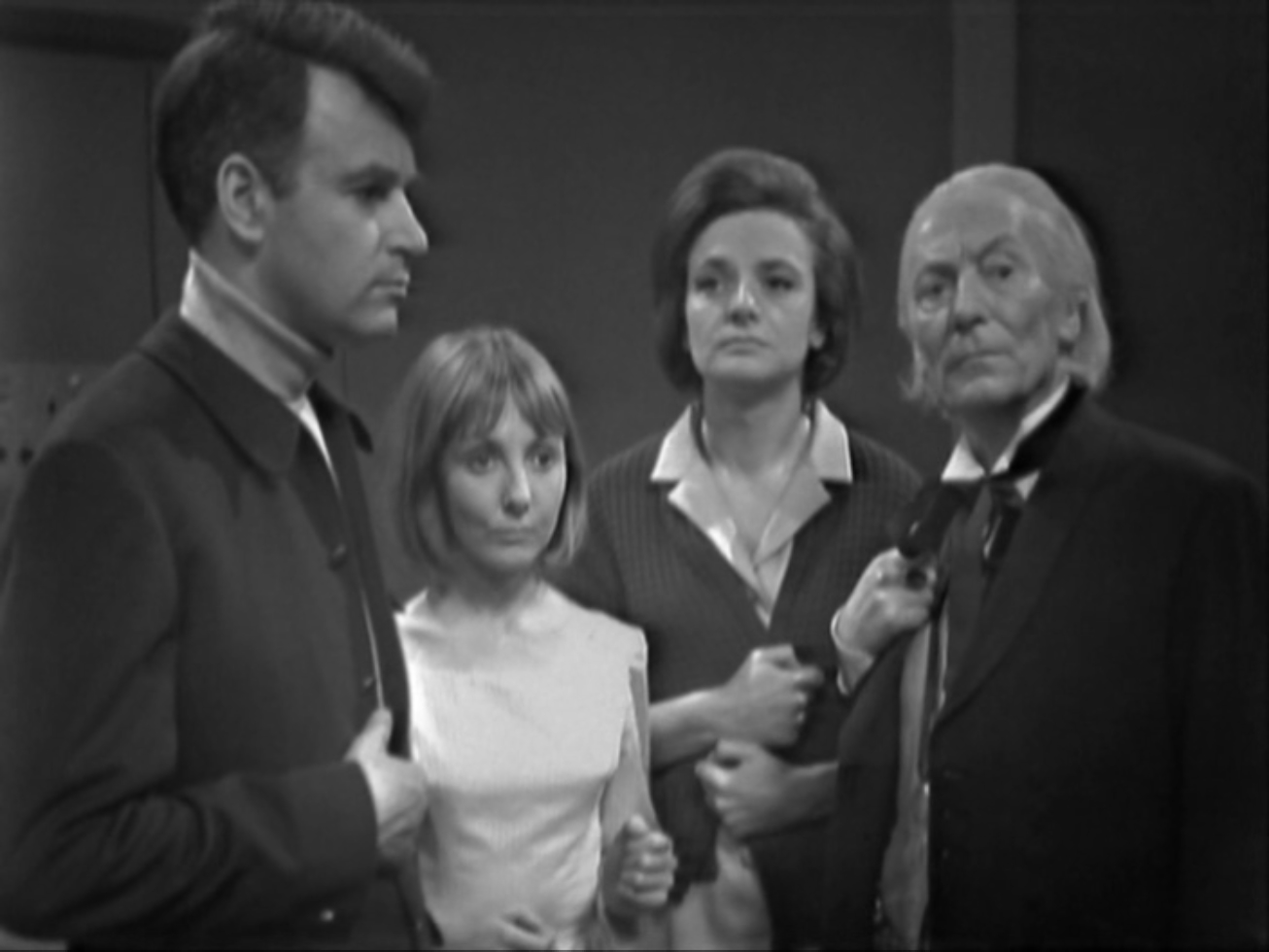
It's hard to get an interesting image of people waiting for something interesting to happen.
The Doctor decides that they should wait around for themselves to actually arrive, at which point time should sort itself out and things will progress as normal.
But…but wouldn’t they still be moving forwards in time so that their true-present selves would never actually catch up with their slightly-out-of-sync-with-the-rest-of-spacetime selves?
Let’s upgrade that headache to a migraine, shall we?
It doesn’t take long before there’s some sort of reversal of time. Two men discover the TARDIS, and the glass cases disappear, and the footprints in the sand turn up.
I might need a diagram to get this straight.
So, the serial opens with an interesting and often creepy episode. The sterile atmosphere of the museum and the deep quiet of the space creates an uncanny feeling, and appropriately enough a sense that there is no time in this place at all. We’ve got some interesting visual effects on display too, and although I do find the explanation of the time-bending shenanigans to be quite confusing, I do find it an interesting idea. Can the companions discover what led them to be museum pieces in time to avert their fate, or are they going to have to find out the hard way?

Nice hairdo.
THE DIMENSIONS OF TIME
I think it’s about time some other characters were introduced, don’t you? Say hello to the curators of this museum, the Moroks. They’re not doing anything very interesting right now apart from talking about some rebellion and finding the TARDIS.
Speaking of rebellion, say hello to the Xerons and their fascinating eyebrows. They’ve also learned of the arrival of a new ship, and hope to attain the assistance of the new arrivals.
Said arrivals are currently flouting the ‘do not touch’ rule and nicking one of the guns on display. Ian, grown man that he is, even makes the appropriate noises as he waves it around. Don’t worry Ian, I’m not judging you… much.
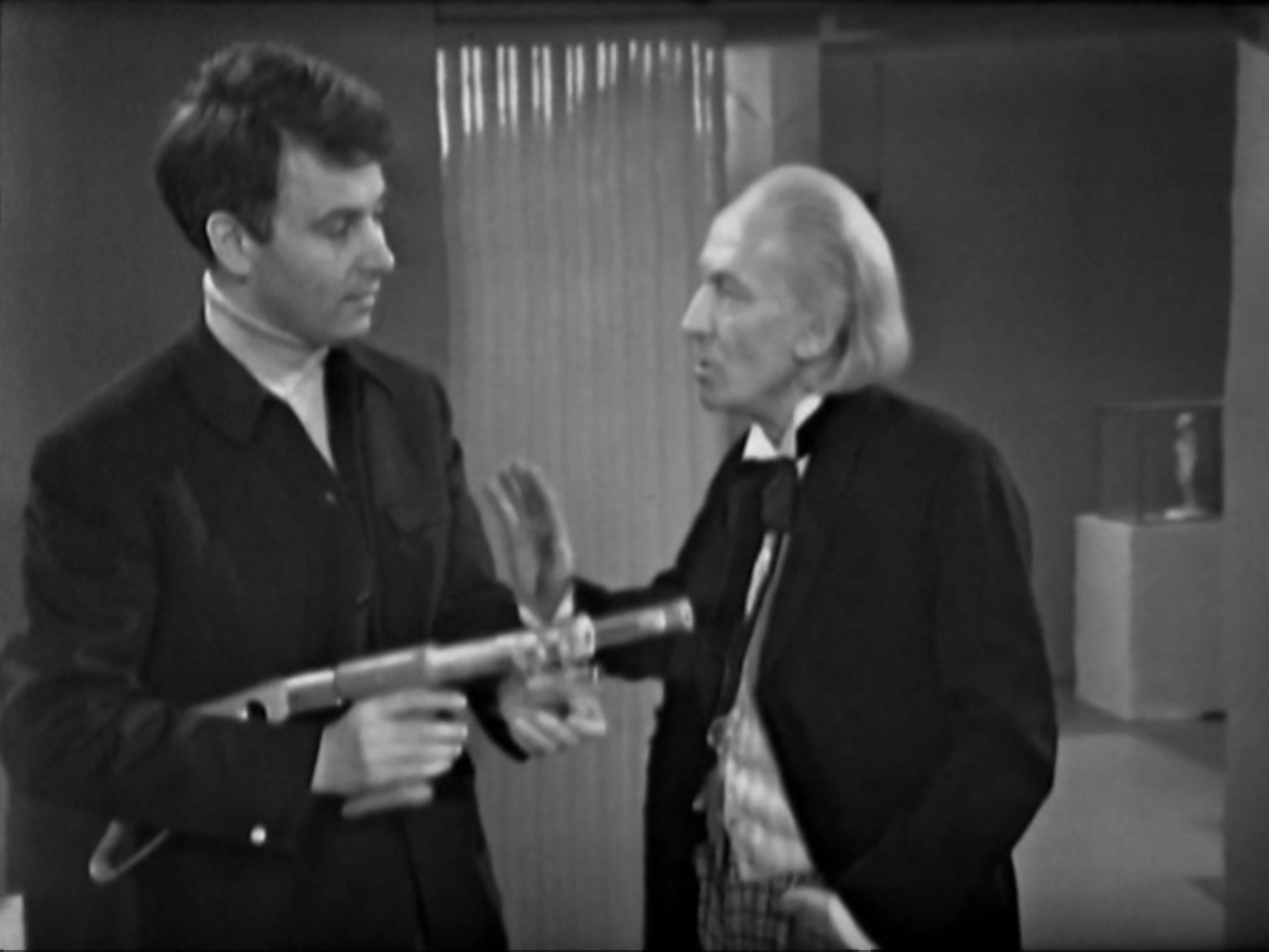
The Doctor decides that to avoid the future they’ve seen, they should try and find the TARDIS as soon as possible. However, that’s easier said than done, because this museum doesn’t have any signposts. Not even one of those handy wall maps with a big red dot saying ‘you are here’.
As the group travel, the Xerons nab the Doctor in a moment of distraction, and the Doctor bravely drops down and pretends to be dead. It doesn’t take long for Ian and Barbara to realise the Doctor’s gone missing, and start bickering like a pair of stressed parents wondering the whereabouts of an errant child, and if that doesn’t sum up their entire dynamic I don’t know what does.
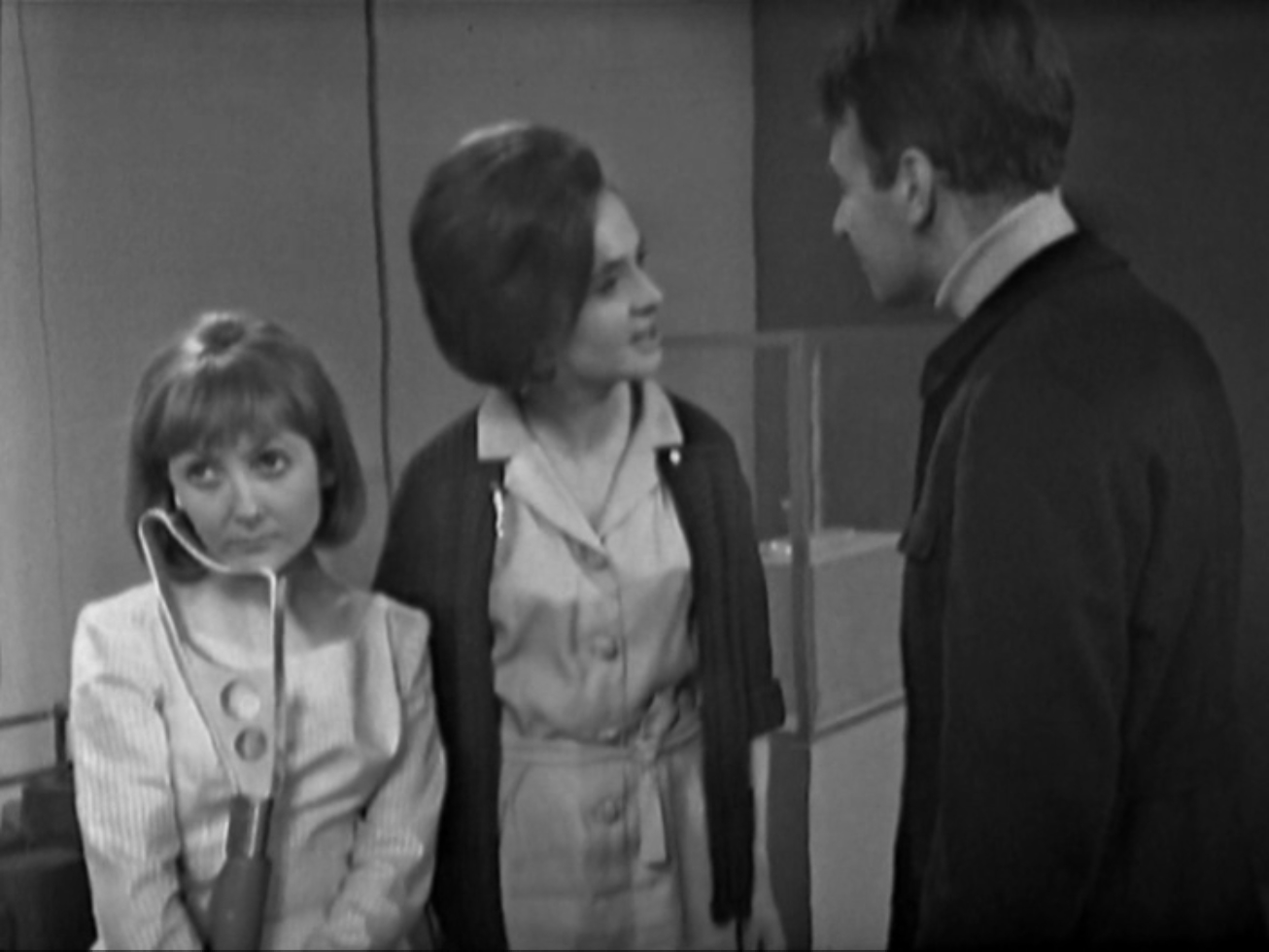
Two of the Xerons make the mistake of leaving one of their number alone with the Doctor for more than five minutes, returning to find their comrade bound and gagged on the floor, and the Doctor nowhere to be seen.
This precedes the single best scene in all of Doctor Who. I’m not exaggerating. I cannot do justice to the sheer joy this scene brought me.
We slowly pan across to see the Dalek on display come to life, and from within comes a familiar voice.
The Doctor does a delightful Dalek impression as he congratulates himself on his cleverness, even waving the weapons around for good measure, and popping out of the hatch with an expression of pure glee.
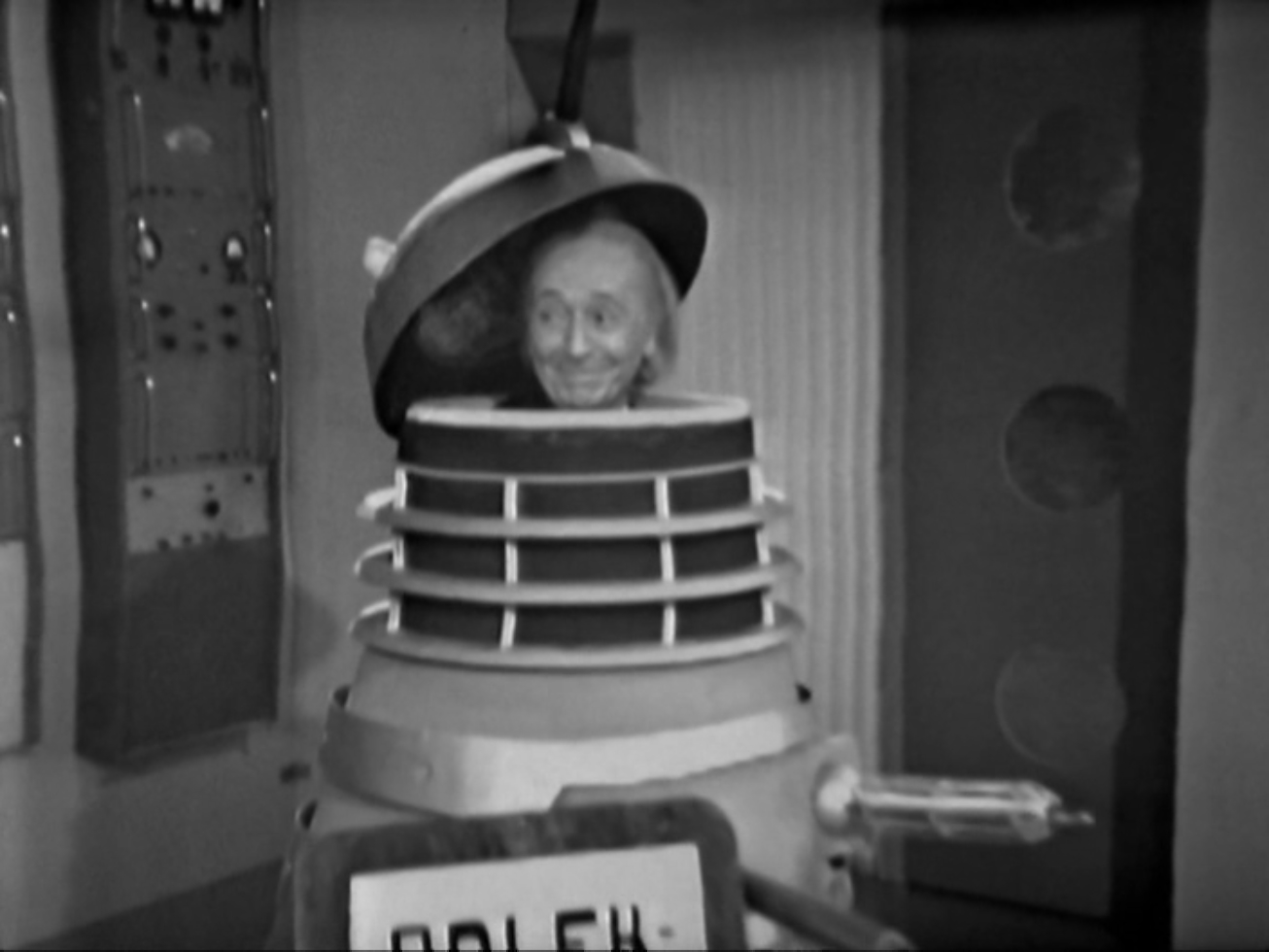
He’s a little too pleased with himself, however, as it takes him all of about ten seconds to run right into some Moroks on patrol and get himself captured.
The others, meanwhile, are still lost. While wondering what to do Ian has a bright idea and starts taking Barbara’s clothes off. As you do.
Don’t worry, the programme is still perfectly suitable for a family audience. Ian’s had the idea to use the wool in her cardigan to leave a trail behind them, like Theseus and the Minotaur, so that they don’t end up going round and round in circles. It’s not long before the Xerons start to follow the thread too, and the companions discover that the TARDIS has fallen into the hands of the Moroks.
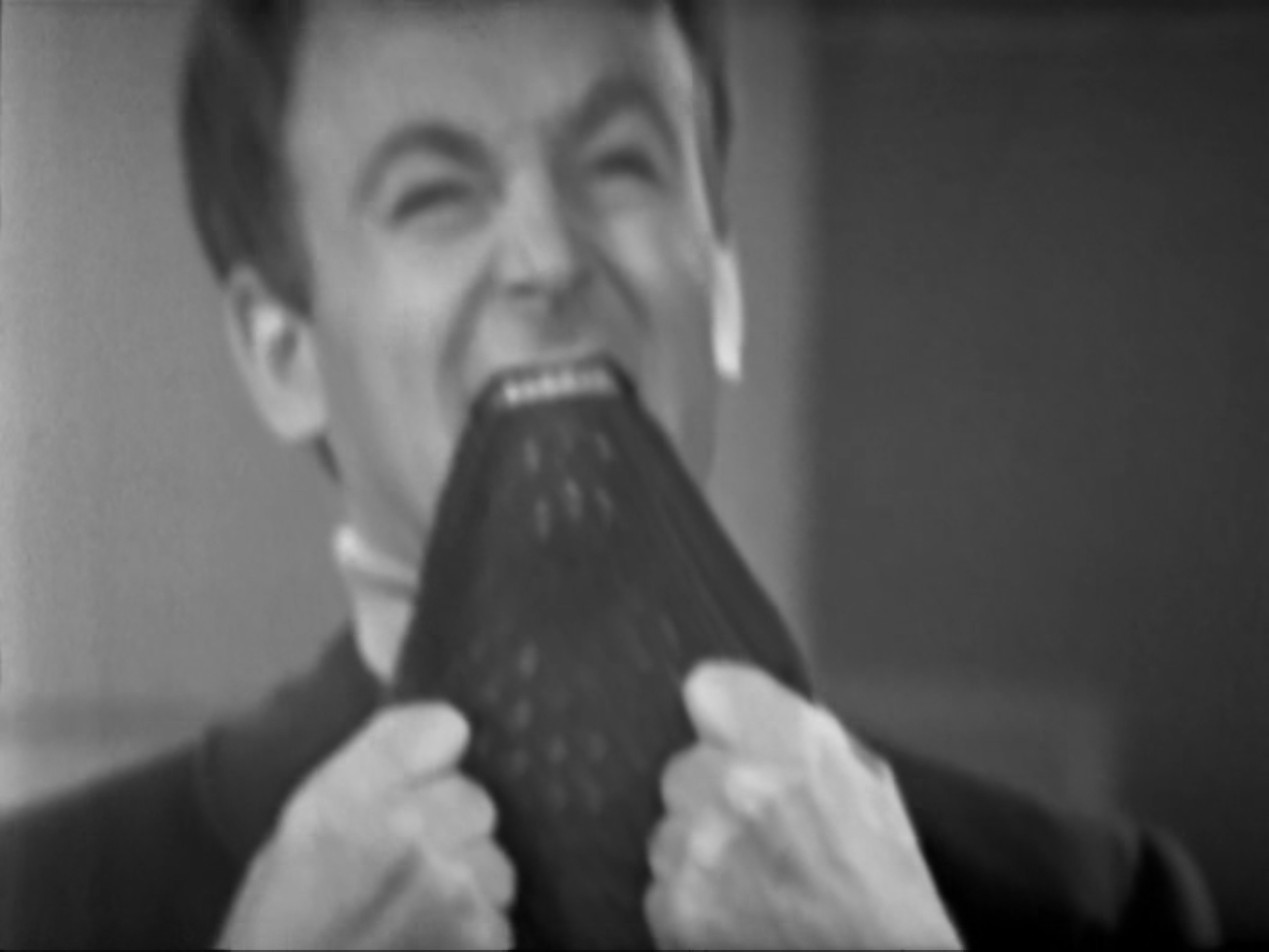 Ian demonstrating how NOT to unpick a piece of knitwear.
Ian demonstrating how NOT to unpick a piece of knitwear.
The Doctor finds himself in the company of the governor of the Moroks, who explains to him this is a museum dedicated to the military conquests of the Morok Empire, though interest has waned of late. It seems the people of the homeworld are more interested in enjoying life than ending it in insatiable imperial expansion. The Doctor suggests that they try reducing the price of admission.
The Morok asks where the Doctor’s companions are, getting naught but a giggle from him. However, he then shows the Doctor an image of the companions elsewhere in the museum. How did he get it? From the Doctor’s mind.
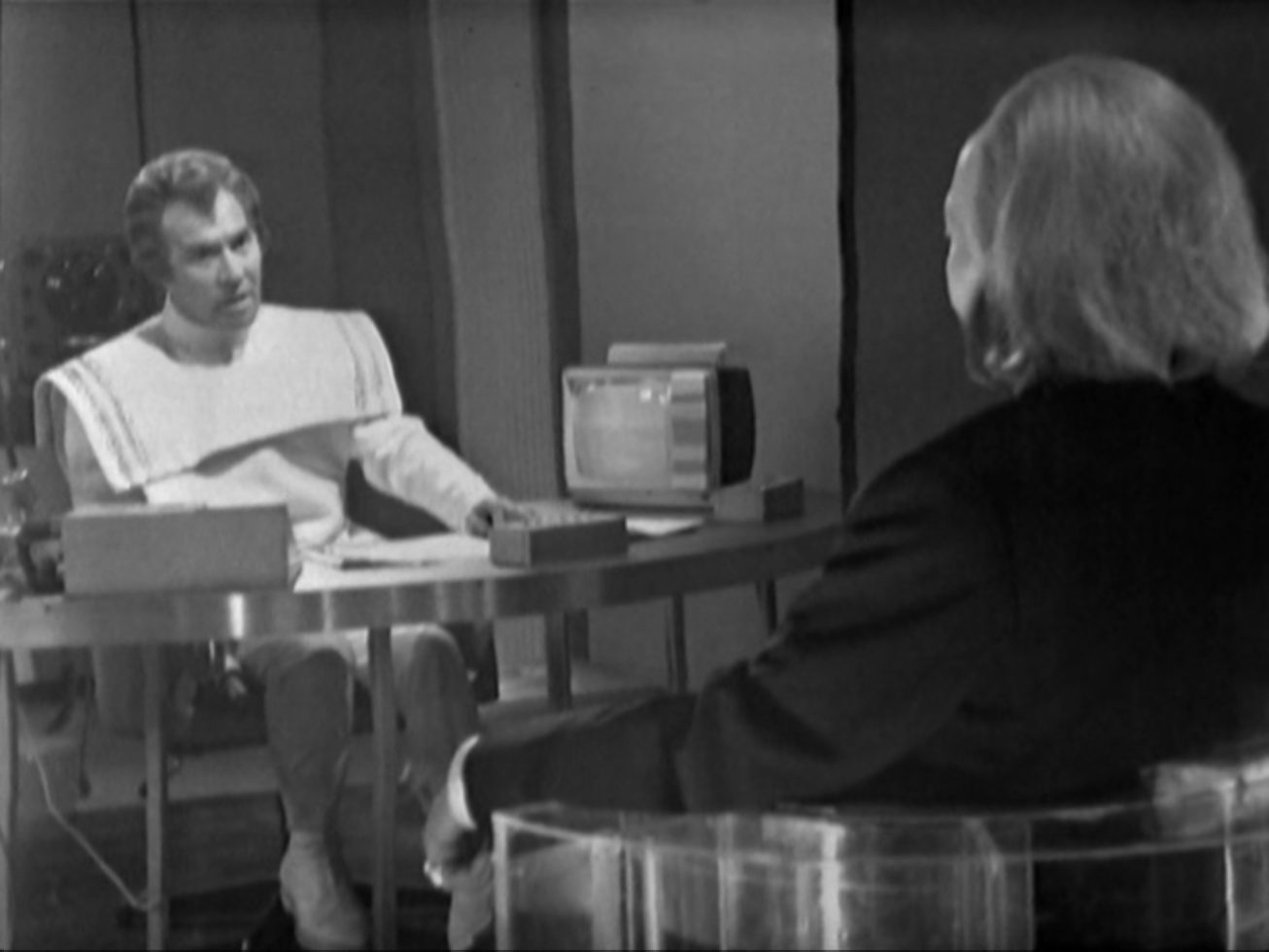
The interrogation isn’t as easy as all that however, as it seems the Doctor has excellent control over his mind, and when asked how he arrived, thinks of a penny farthing, and when asked where he’s from, imagines a colony of walruses, followed by a picture of himself in an old-fashioned bathing suit. It’s quite funny.
The fun and games can’t last, however, as the governor becomes angry when his men can’t find the companions, and orders that the Doctor be taken to the preparation room. He’s to become an exhibit.
THE SEARCH
The Moroks can’t get into the TARDIS, much to the lamentation of the leader of this little band.
Here’s one of the issues of the serial. The conflict within the Moroks themselves is… boring. It’s just dull as ditchwater, and the performances are not strong enough to carry it on entertainment value or get me invested in any of the characters. What are their names? I don’t know and I don’t care.
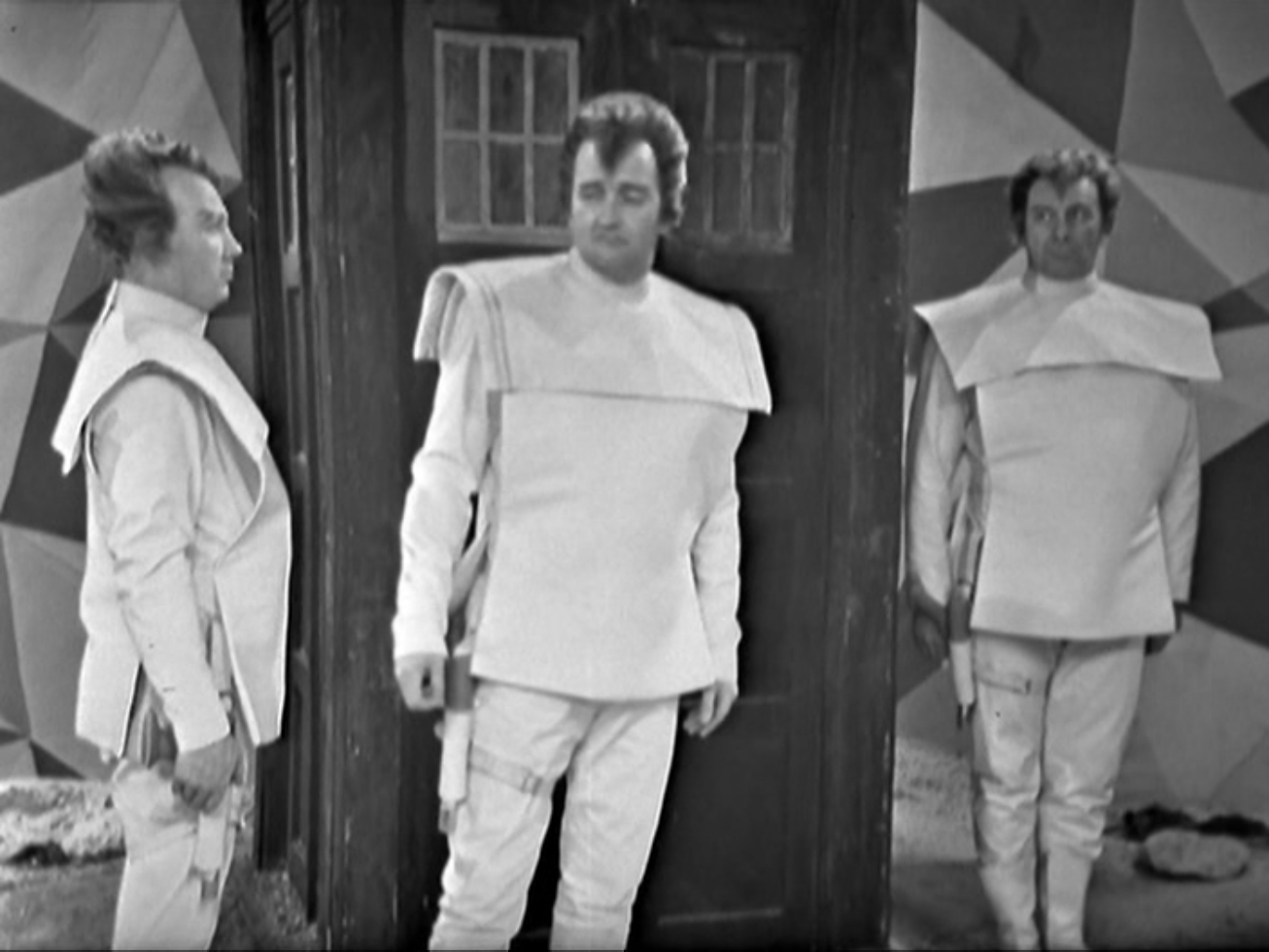
Do you think they realise how ridiculous they look?
Even the wider conflict between the Moroks and the Xerons is not interesting to me. We’ve seen it plenty of times before in Doctor Who, and done better. I think what the writer’s trying to do is ambitious, but it feels very flat to me. Unfortunately, it gets more attention than the strange time travel shenanigans, so it’s really dragging down the serial, and it’s only going to get worse.
Watching this bickering going on, the companions let down their guard long enough for one of the Moroks to find them, and Ian confronts the armed guard with impressive courage and questionable judgement. He figures that the guard can’t shoot him, as he knows he ends up in a glass box. Even if he does, well hurrah for averting the future. Well, I suppose either outcome is a success of sorts.
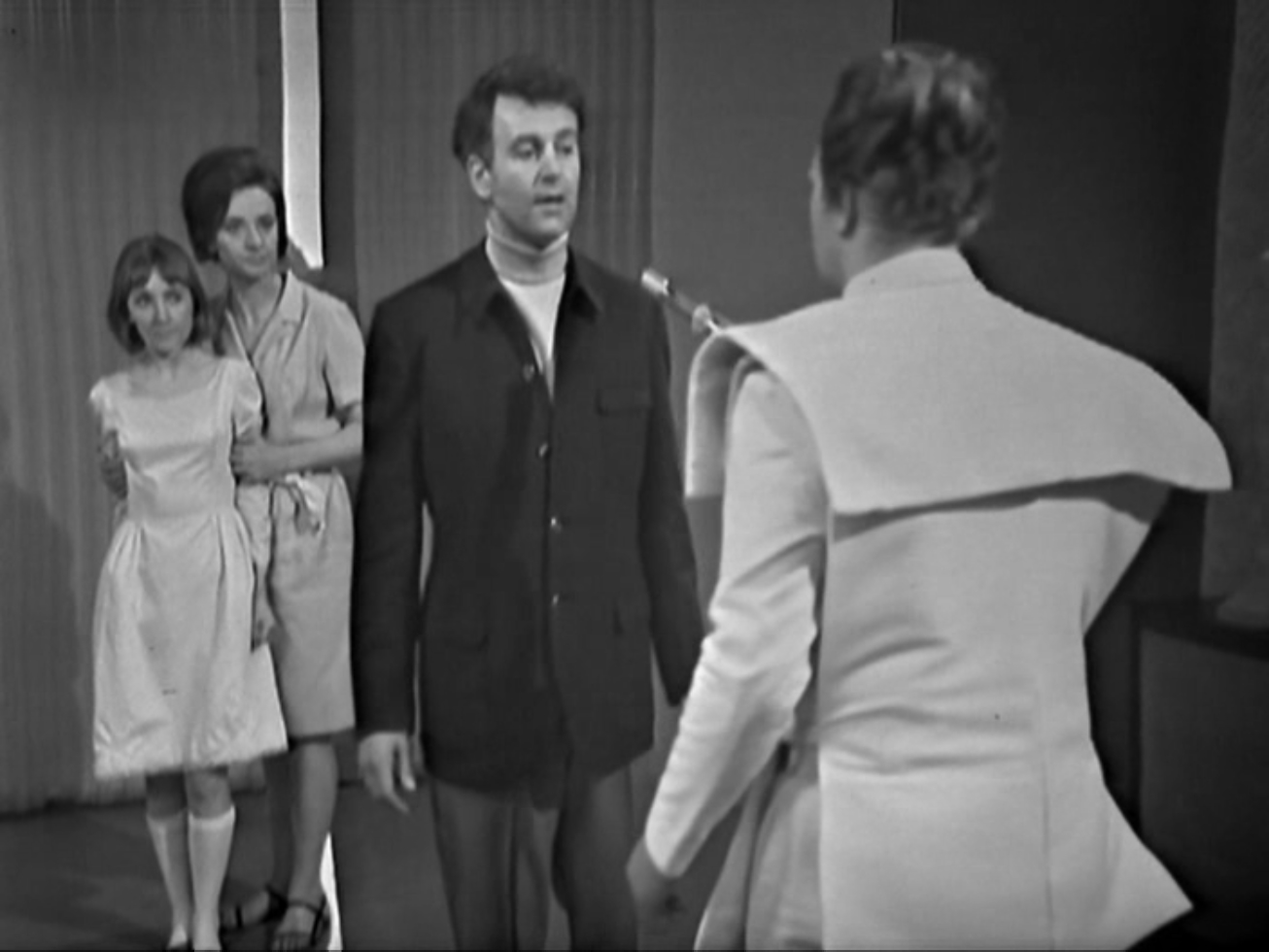
Ian faces the guard, while behind him, Barbara prepares to use Vicki as a human shield.
Ian tackles the guard, giving the others a chance to make a run for it, and there’s rather a good and well-choreographed fight scene following his ensuing capture. Often fight scenes in Doctor Who are shot quite close up and are hard to make much out of, and those that are shot more clearly often look absurd, but this one is both clear and believable. At the end of it, he’s left two Moroks out cold, as the others left in pursuit of the women.
The women are separated in the chase, with Barbara ending up trapped in a storage room, and Vicki running into the rebel Xerons. Thankfully, the Xerons are friendly, and one of them goes to look for Barbara while the others lead Vicki to their hideout.
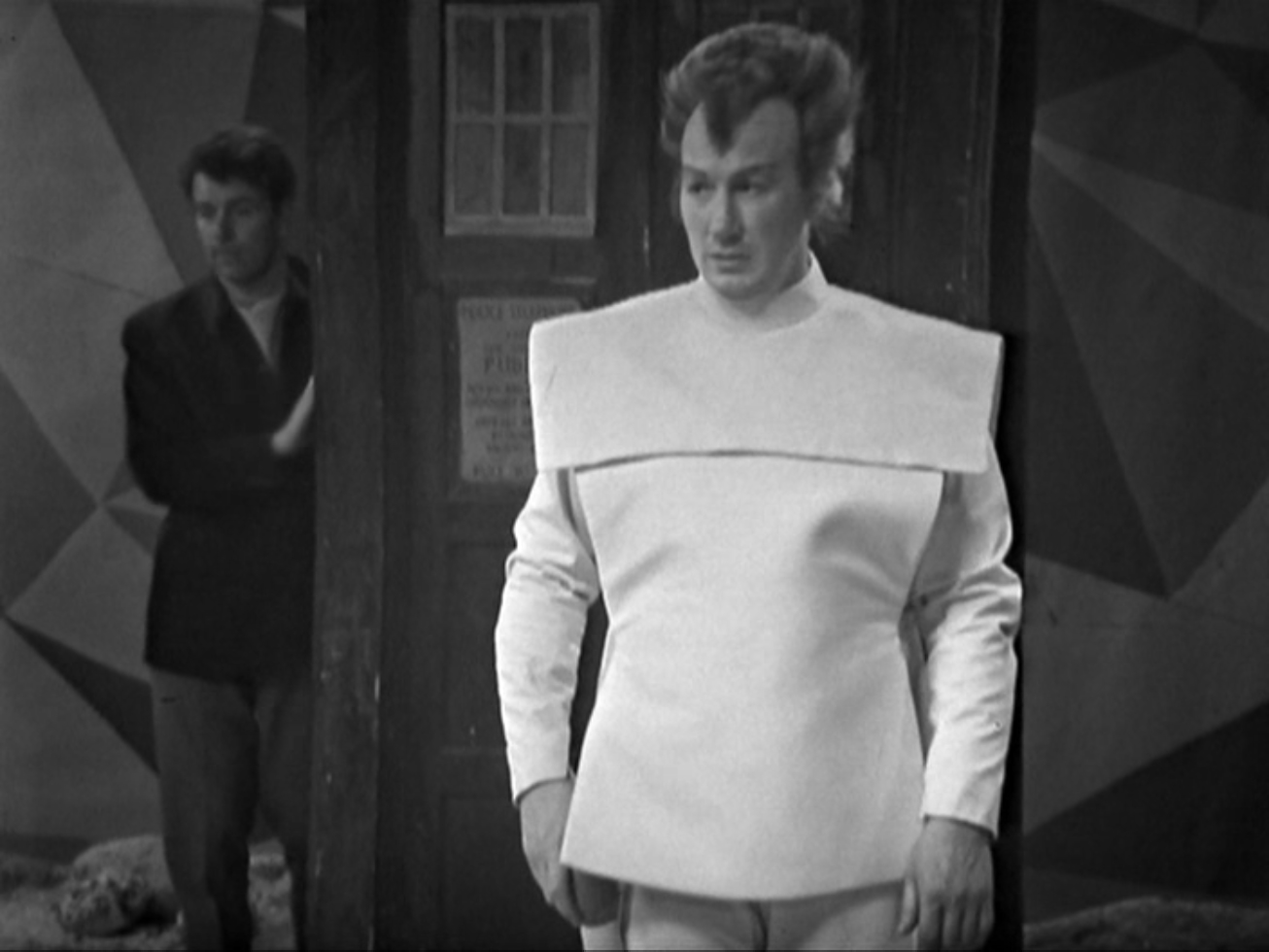
So, how did Ian escape the Moroks after his victory in the tussle? Well, apparently by virtue of the Moroks being utter clattering buffoons, that’s how. You want to know where he went? His brilliant hiding spot? Behind the flipping TARDIS. Just behind it. And somehow, the guard stationed outside the ship fails to notice him.
Ian surprises the guard and takes him hostage, holding him at gunpoint as he demands information and guidance. This is another thing that bothers me.
Yes, we know Ian is the action hero of the group. Yes, Ian’s absolutely killed people. However, all his kills have been in the heat of the moment, when his own life was in danger, and it’s quite disturbing to see him carry on for the rest of the episode threatening to shoot this guard in cold blood. Wouldn’t Ian instead try to bring the guard around to his side before resorting to threats of violence? This is a cold, angry Ian and it doesn’t seem like him to be this way. Besides all that, it doesn’t seem a good message to be sending to the younger viewers. ‘Why try talking to people when threats of violence will work just fine?’
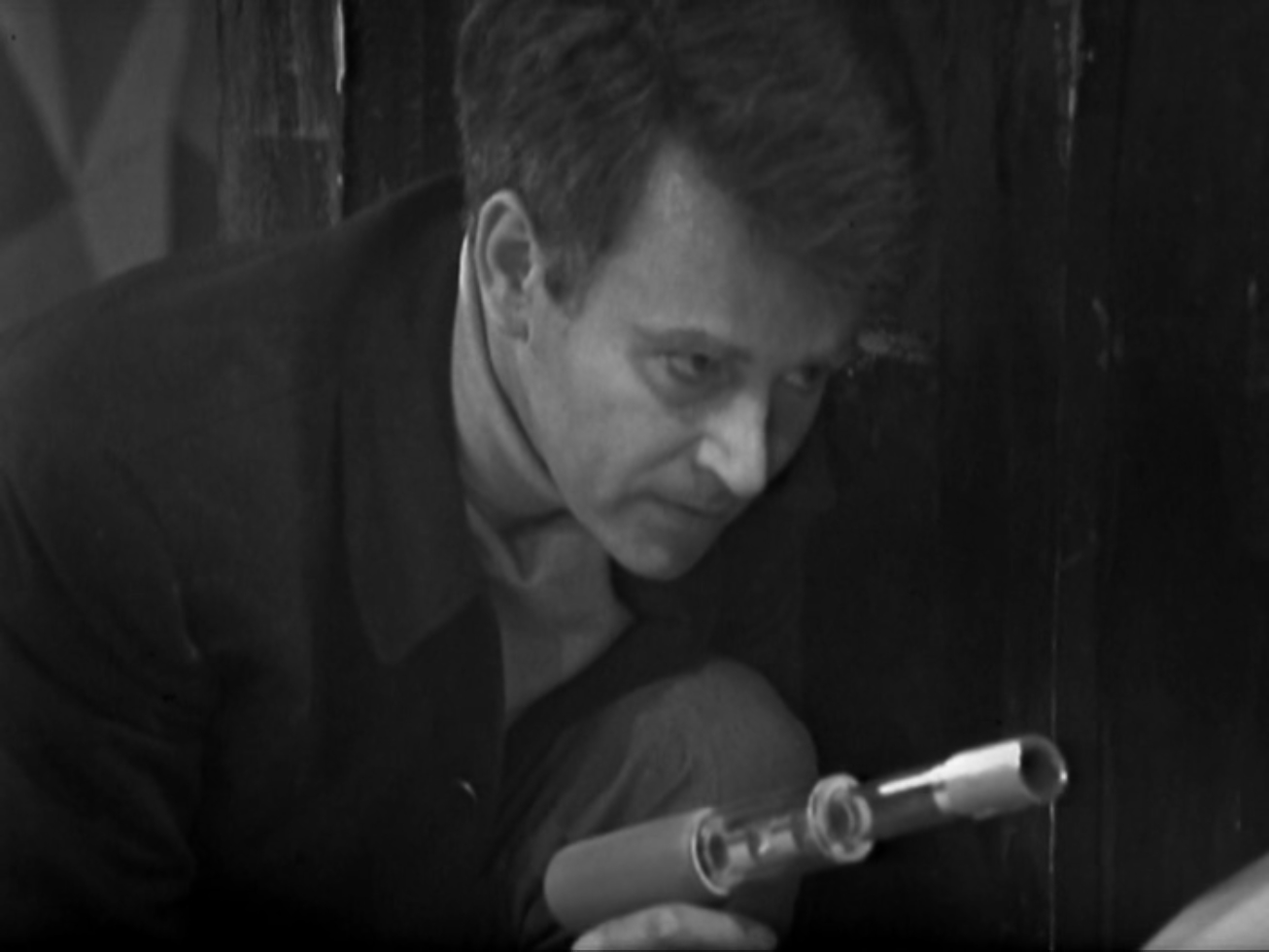
The governor of the Moroks receives word from his home planet that they’re displeased the youth rebellion hasn’t been crushed yet, and gives the order to flood the museum with a poisonous gas that will paralyse everyone inside, to flush out the intruders.
Putting it that way, it seems a little flawed.
One of the Xerons manages to find Barbara, but before they can find the others the gas cloud envelops them and they have to flee.
Meanwhile, the others are explaining to Vicki that this is their world, that the Moroks committed genocide on the native population, wiping out the adults and enslaving the children. Is that meant to get me invested, three quarters of the way into the serial? No need to actually show us the oppression the Xerons face, or give us much in the way of emotional stakes, just throw in a line about mass murder and voila, you have an invested audience, right? Wrong.

To get invested in a conflict, I need to be shown a reason to care about it early on, rather than have a lump of exposition spat at me most of the way through. Beyond that, this narrative of ‘rebellion against the conquerors’ feels like a retreading of the conflict in The Web Planet, but it’s much less interesting.
So, how’s the dullest rebellion in the galaxy going to overthrow their oppressors? Well, they haven’t actually worked that out. The youth have been making all sorts of grand plans, but the fact is they don’t have any weapons and no plan to get some. What they do have is knowledge of where to find the armoury, and a smart ally by the name of Vicki.

Vicki examines the security equipment guarding the armoury. It’s a machine that asks questions, and can tell if the subject is lying. Of course, just telling the truth isn’t enough to get in, you have to be telling the truth about your credentials, permits, valid reason for accessing the armoury, and on and on the questions go. Understanding how the machine works, Vicki cracks it open to take a look inside, and tampers with the equipment, making it so that all that’s needed is the truth, not the credentials.
Well, that’s a bit of a rubbish security system if it can be tampered with that easily. Had none of the Xerons ever thought to try it?
However, with one small victory, elsewhere things go awry, as the gas overcomes Barbara and the other Xeron.
Ian manages to make his way to the governor’s office, and orders him to take him to the Doctor… but he doesn’t like what he finds.
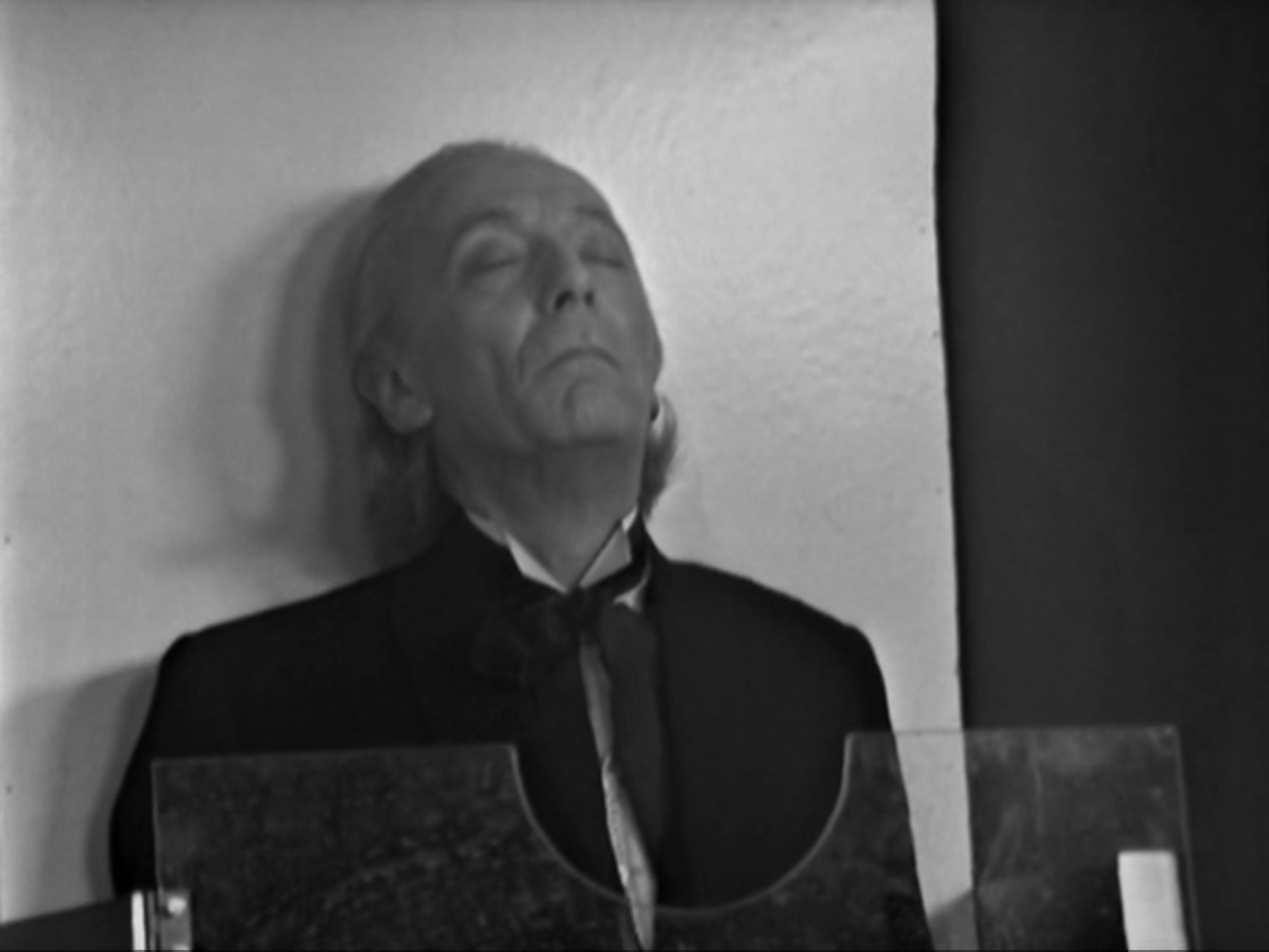
THE FINAL PHASE
To his dismay, Ian finds the Doctor unconscious in the preparation room. The Moroks have put him into a deep freeze, and according to the governor he’s as good as dead. Ian demands that they reverse the procedure, or else.
Having successfully broken into the armoury, the rebels arm themselves, while Vicki goes back to the museum to rescue the others, taking one of the young men with her.
Inside the museum, Barbara and her companion start to recover from the gas. Well, that was a bit pointless, wasn’t it? Surely it’d be better if the effects took a long time to wear off, so the guards could remove the gas then search the museum without their targets being able to move around.

The Doctor’s temperature returns to normal, and he wonders if this has been enough to change the future. However, the Moroks, having noticed that the guard outside the TARDIS has disappeared, swoop in on them, knocking Ian out and taking the pair captive once more. Well, that was a bit of a narrative cul-de-sac.
Barbara and her companion continue making their way out of the museum, but a guard hears them coming, and lies in wait to capture them.
The Moroks regroup, and it seems that their victory is close at hand. However, when they try to get a message through to their barracks, they don’t get a reply.
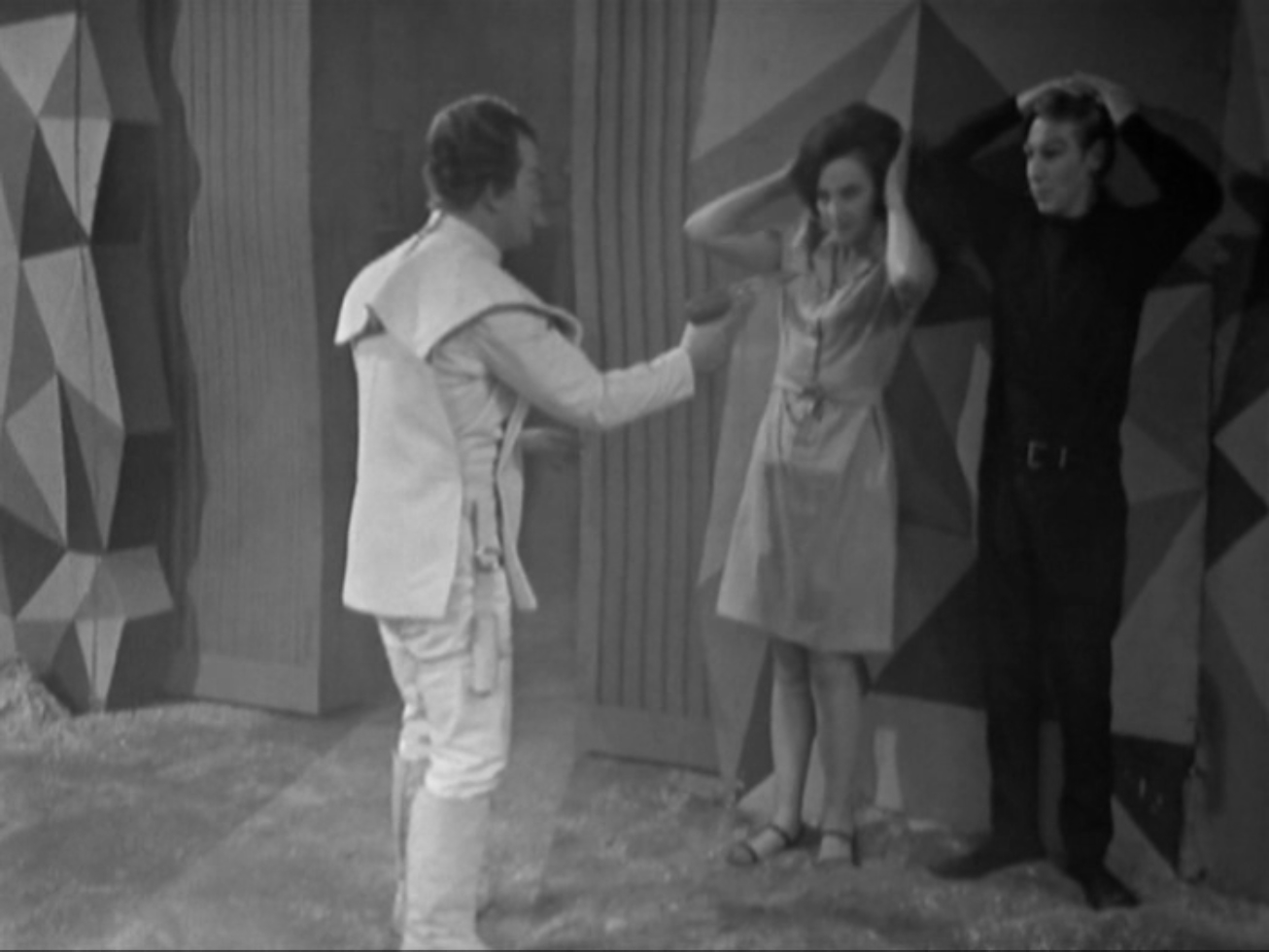
Barbara and her companion emerge from the museum, only to run into the waiting guard. But before their escape can be foiled, Vicki and her friend show up and shoot the guard down. The victory doesn’t last long, as more Moroks arrive and shoot the youth rebels, taking the women captive. Again.
Well, with all the gang captured, at least everybody’s together now. It seems there is nothing they can do to avoid becoming exhibits, but maybe they managed to change more than they thought. The youth storm the museum, having managed to overrun the barracks which happened off-screen probably so that people like me won’t ask questions about how a bunch of teenage boys who have never held a gun managed to overrun a barracks of well-equipped soldiers of an interplanetary empire.
The Moroks are about to cut their losses and make a run for it, but the rebels arrive before the Moroks can dispatch the companions. They wipe them out, and with that, the revolution is won. That is about as interesting as I can make it sound without just making things up.
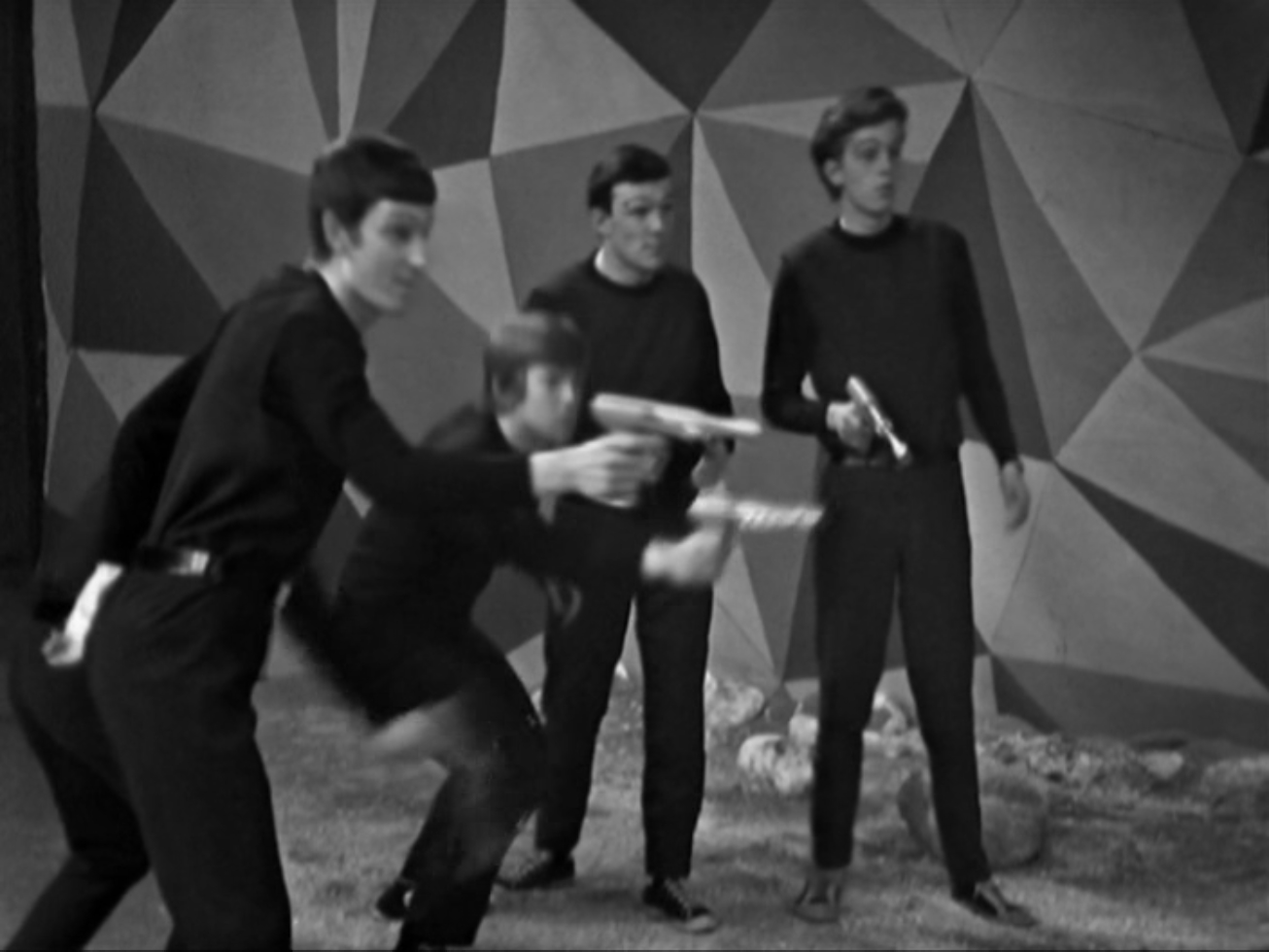
The gang avoid becoming museum pieces, and the future has been averted. The Doctor at last reveals why the weird time shenanigans were going on. Prepare to sigh deeply with me.
It’s a faulty TARDIS component.
Seriously? Nothing to do with the actual plot? That is boring and just plain lazy. With it being so disconnected, the time travel is little more than a gimmick thrown in to make a below-average rebellion story feel more impressive and complex than it actually is. I strongly feel that the element of time travel could have been integrated into the story far better than it actually was, rather than being dropped after the first episode. I could think of a few ways I myself would go about doing it, but perhaps I would be asking for a different story than the one the writer set out to tell.
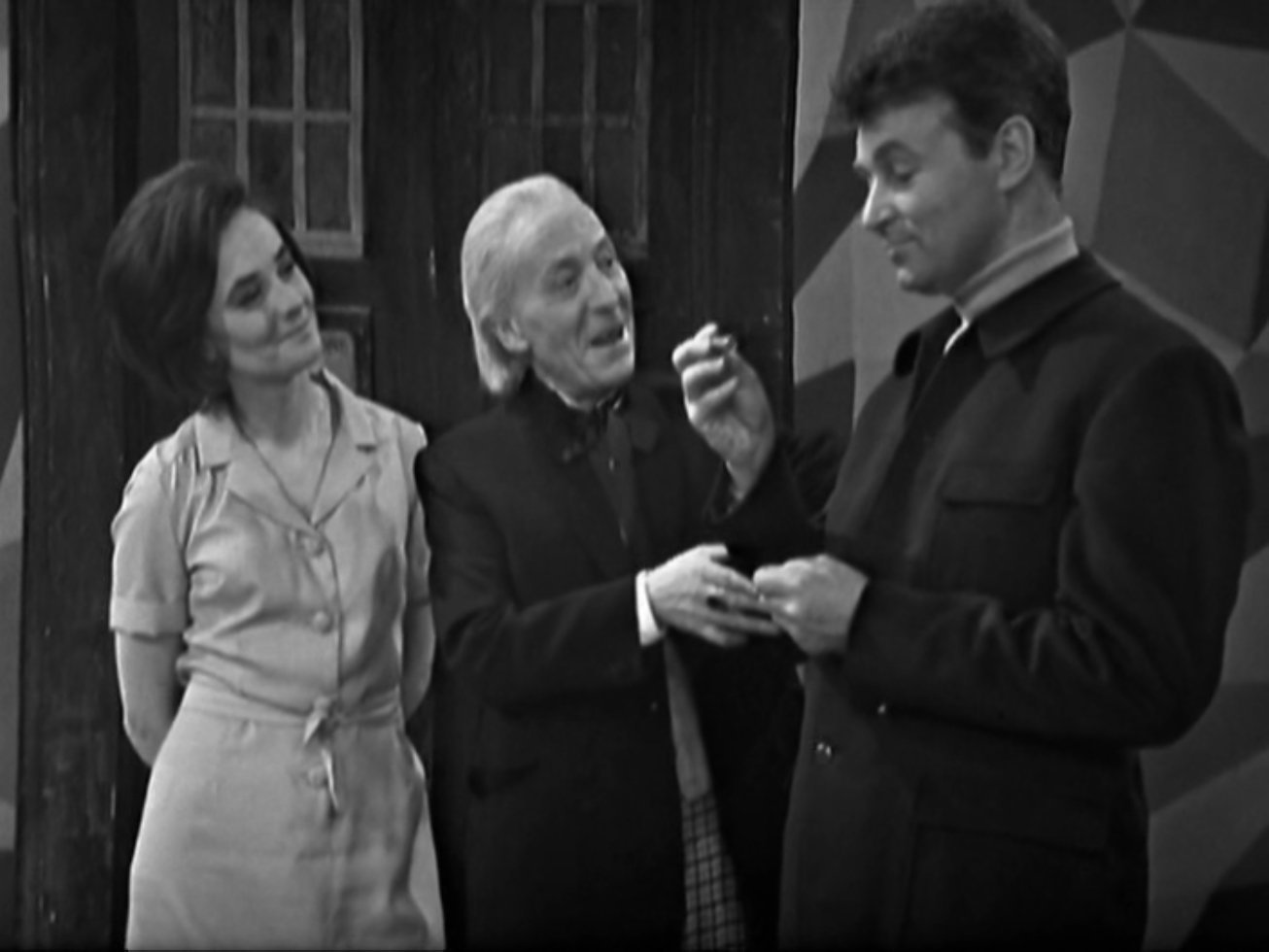
The Xerons dismantle the museum, but not before the Doctor liberates a souvenir, in the form of a time and space visualiser. I suppose it’s like a television you can watch next week’s Coronation Street on.
Everyone says their farewells and the TARDIS leaves for parts unknown. However, somewhere else in space, a familiar foe glides into view…
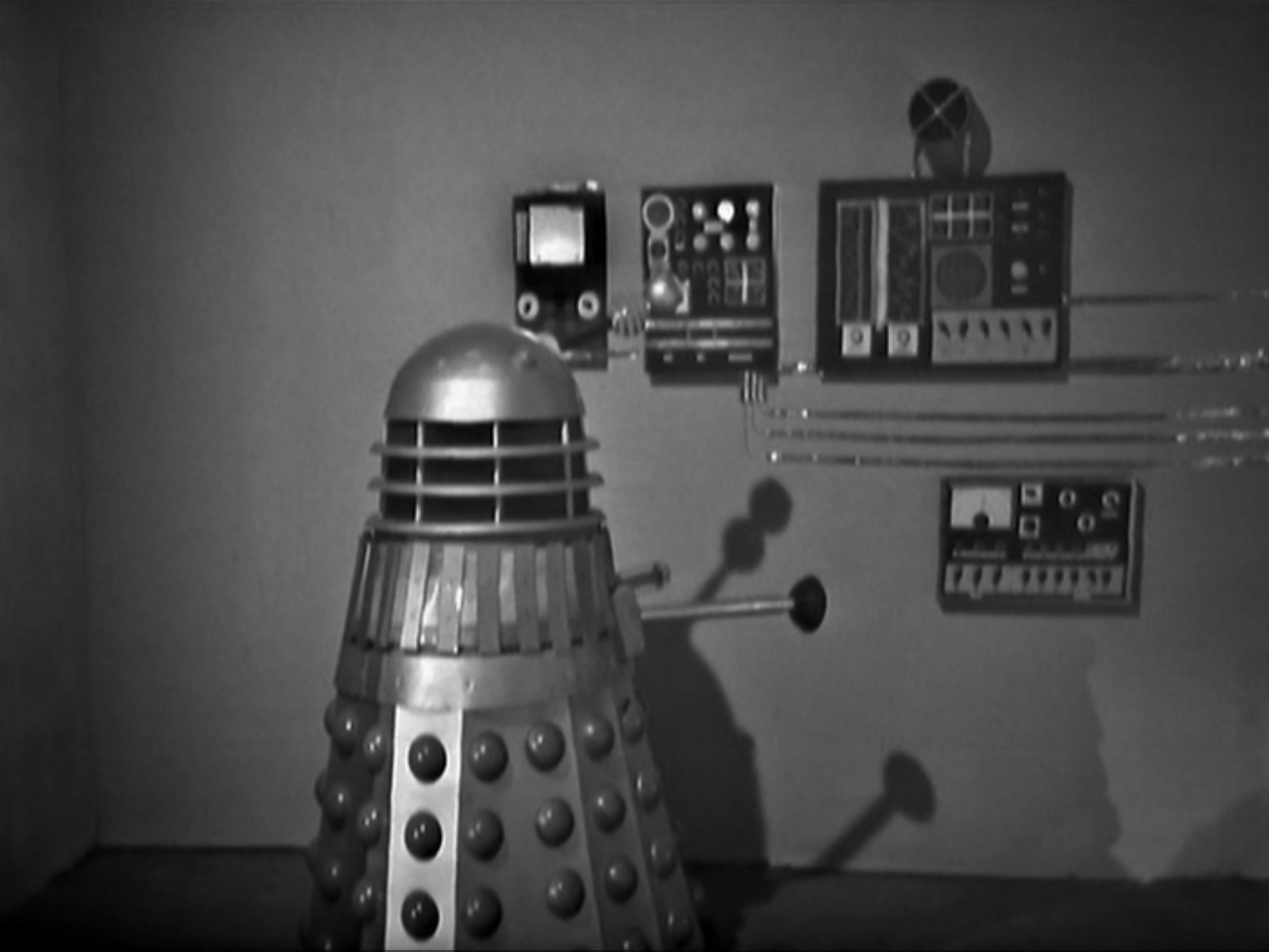
Final Thoughts
This is unusual for me, as a person incapable of shutting up, but I can’t think of anything else to say about this serial. There’s not really anything much to dig into. Sure, the serial poses the question of whether destiny can be altered, but then answers it with a resounding ‘yes’, so there’s nothing I can add to that. It was all right, I suppose. I'll probably have forgotten about it by this time next week.
I really am wracking my brains trying to think of something interesting to say, but there’s nothing to elaborate on that I didn’t discuss above. So, I suppose that’s my takeaway: so adequate-but-no-better that even I can’t wring a good long ramble out if it.
Well, let’s hope there’s a bit more to get our teeth into next time, okay?
Please exit through the gift shop.
3 out of 5 stars

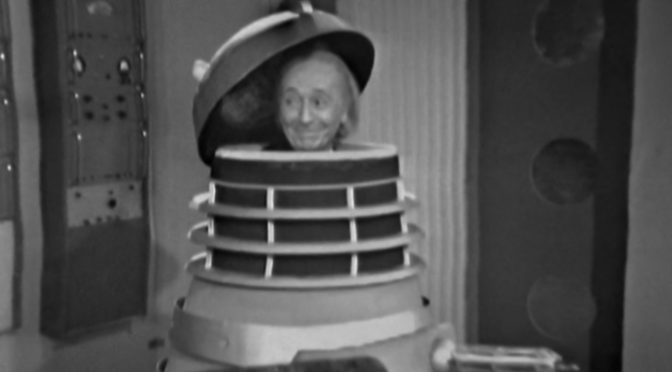

I have to agree to the rebellion plot is very boring but I do feel the regulars have a chance to shine here. Vicki in particular gets a lot of good things to do. I did also enjoy the number of jokey references to previous stories. Showing a nice sense of continuity and also fun.
This has been a bit of my feeling of the last few stories, the regulars hold it together and they are generally good fun, but the actual plots haven't been that strong for a while.
On your question on the effect, it is a superimposure. The objects are recorded on one camera and the cast on another and then they use a video mixer to mean that their output is recorded at the same time. Sounds simple but apparently incredibly tough to do. probably why they brought back Mervyn Penfield.
Yes, I have grown very fond of the regulars. I just hope that the rumours I've heard that certain cast members are leaving the programme soon prove untrue.
Thank you for explaining the effect! That's really neat. It sounds quite an expensive job what with the specialised equipment, but I reckon it was worth it.
When they come to the door of the museum, they seem to be leaving footprints